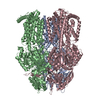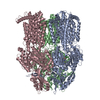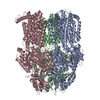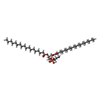+ Open data
Open data
- Basic information
Basic information
| Entry | Database: PDB / ID: 9bft | ||||||
|---|---|---|---|---|---|---|---|
| Title | Cryo-EM co-structure of AcrB with CU244 | ||||||
 Components Components | Multidrug efflux pump subunit AcrB | ||||||
 Keywords Keywords |  TRANSLOCASE / AcrB Multidrug Efflux Pump TRANSLOCASE / AcrB Multidrug Efflux Pump | ||||||
| Function / homology |  Function and homology information Function and homology informationxenobiotic detoxification by transmembrane export across the cell outer membrane /  efflux pump complex / periplasmic side of plasma membrane / xenobiotic transmembrane transporter activity / efflux transmembrane transporter activity / outer membrane-bounded periplasmic space / efflux pump complex / periplasmic side of plasma membrane / xenobiotic transmembrane transporter activity / efflux transmembrane transporter activity / outer membrane-bounded periplasmic space /  membrane / identical protein binding / membrane / identical protein binding /  plasma membrane plasma membraneSimilarity search - Function | ||||||
| Biological species |   Escherichia coli K-12 (bacteria) Escherichia coli K-12 (bacteria) | ||||||
| Method |  ELECTRON MICROSCOPY / ELECTRON MICROSCOPY /  single particle reconstruction / single particle reconstruction /  cryo EM / Resolution: 2.44 Å cryo EM / Resolution: 2.44 Å | ||||||
 Authors Authors | Su, C.C. | ||||||
| Funding support |  United States, 1items United States, 1items
| ||||||
 Citation Citation |  Journal: mBio / Year: 2023 Journal: mBio / Year: 2023Title: Bacterial efflux pump modulators prevent bacterial growth in macrophages and under broth conditions that mimic the host environment. Authors: Samual C Allgood / Chih-Chia Su / Amy L Crooks / Christian T Meyer / Bojun Zhou / Meredith D Betterton / Michael R Barbachyn / Edward W Yu / Corrella S Detweiler /  Abstract: New approaches for combating microbial infections are needed. One strategy for disrupting pathogenesis involves developing compounds that interfere with bacterial virulence. A critical molecular ...New approaches for combating microbial infections are needed. One strategy for disrupting pathogenesis involves developing compounds that interfere with bacterial virulence. A critical molecular determinant of virulence for Gram-negative bacteria are efflux pumps of the resistance-nodulation-division family, which includes AcrAB-TolC. We previously identified small molecules that bind AcrB, inhibit AcrAB-TolC, and do not appear to damage membranes. These efflux pump modulators (EPMs) were discovered in an in-cell screening platform called SAFIRE (Screen for Anti-infectives using Fluorescence microscopy of IntracellulaR Enterobacteriaceae). SAFIRE identifies compounds that disrupt the growth of a Gram-negative human pathogen, serotype Typhimurium (. Typhimurium), in macrophages. We used medicinal chemistry to iteratively design ~200 EPM35 analogs and test them for activity in SAFIRE, generating compounds with nanomolar potency. Analogs were demonstrated to bind AcrB in a substrate binding pocket by cryo-electron microscopy. Despite having amphipathic structures, the EPM analogs do not disrupt membrane voltage, as monitored by FtsZ localization to the cell septum. The EPM analogs had little effect on bacterial growth in standard Mueller Hinton Broth. However, under broth conditions that mimic the micro-environment of the macrophage phagosome, is required for growth, the EPM analogs are bacteriostatic, and the EPM analogs increase the potency of antibiotics. These data suggest that under macrophage-like conditions, the EPM analogs prevent the export of a toxic bacterial metabolite(s) through AcrAB-TolC. Thus, compounds that bind AcrB could disrupt infection by specifically interfering with the export of bacterial toxic metabolites, host defense factors, and/or antibiotics.IMPORTANCEBacterial efflux pumps are critical for resistance to antibiotics and for virulence. We previously identified small molecules that inhibit efflux pumps (efflux pump modulators, EPMs) and prevent pathogen replication in host cells. Here, we used medicinal chemistry to increase the activity of the EPMs against pathogens in cells into the nanomolar range. We show by cryo-electron microscopy that these EPMs bind an efflux pump subunit. In broth culture, the EPMs increase the potency (activity), but not the efficacy (maximum effect), of antibiotics. We also found that bacterial exposure to the EPMs appear to enable the accumulation of a toxic metabolite that would otherwise be exported by efflux pumps. Thus, inhibitors of bacterial efflux pumps could interfere with infection not only by potentiating antibiotics, but also by allowing toxic waste products to accumulate within bacteria, providing an explanation for why efflux pumps are needed for virulence in the absence of antibiotics. | ||||||
| History |
|
- Structure visualization
Structure visualization
| Structure viewer | Molecule:  Molmil Molmil Jmol/JSmol Jmol/JSmol |
|---|
- Downloads & links
Downloads & links
- Download
Download
| PDBx/mmCIF format |  9bft.cif.gz 9bft.cif.gz | 1.1 MB | Display |  PDBx/mmCIF format PDBx/mmCIF format |
|---|---|---|---|---|
| PDB format |  pdb9bft.ent.gz pdb9bft.ent.gz | Display |  PDB format PDB format | |
| PDBx/mmJSON format |  9bft.json.gz 9bft.json.gz | Tree view |  PDBx/mmJSON format PDBx/mmJSON format | |
| Others |  Other downloads Other downloads |
-Validation report
| Arichive directory |  https://data.pdbj.org/pub/pdb/validation_reports/bf/9bft https://data.pdbj.org/pub/pdb/validation_reports/bf/9bft ftp://data.pdbj.org/pub/pdb/validation_reports/bf/9bft ftp://data.pdbj.org/pub/pdb/validation_reports/bf/9bft | HTTPS FTP |
|---|
-Related structure data
| Related structure data |  44506MC  9bfhC  9bfmC  9bfnC M: map data used to model this data C: citing same article ( |
|---|---|
| Similar structure data | Similarity search - Function & homology  F&H Search F&H Search |
- Links
Links
- Assembly
Assembly
| Deposited unit | 
|
|---|---|
| 1 |
|
- Components
Components
| #1: Protein | Mass: 113665.180 Da / Num. of mol.: 3 Source method: isolated from a genetically manipulated source Source: (gene. exp.)   Escherichia coli K-12 (bacteria) / Gene: acrB, acrE, b0462, JW0451 / Production host: Escherichia coli K-12 (bacteria) / Gene: acrB, acrE, b0462, JW0451 / Production host:   Escherichia coli K-12 (bacteria) / References: UniProt: P31224 Escherichia coli K-12 (bacteria) / References: UniProt: P31224#2: Chemical |  Phosphatidylethanolamine Phosphatidylethanolamine#3: Chemical | ChemComp-A1AOF / ( | Mass: 317.211 Da / Num. of mol.: 1 / Source method: obtained synthetically / Formula: C14H18Cl2N2O2 / Feature type: SUBJECT OF INVESTIGATION #4: Water | ChemComp-HOH / |  Water WaterHas ligand of interest | Y | |
|---|
-Experimental details
-Experiment
| Experiment | Method:  ELECTRON MICROSCOPY ELECTRON MICROSCOPY |
|---|---|
| EM experiment | Aggregation state: PARTICLE / 3D reconstruction method:  single particle reconstruction single particle reconstruction |
- Sample preparation
Sample preparation
| Component | Name: H6PD / Type: COMPLEX / Entity ID: #1 / Source: NATURAL |
|---|---|
| Source (natural) | Organism:   Homo sapiens (human) Homo sapiens (human) |
| Buffer solution | pH: 7.5 |
| Specimen | Conc.: 0.5 mg/ml / Embedding applied: NO / Shadowing applied: NO / Staining applied : NO / Vitrification applied : NO / Vitrification applied : YES : YESDetails: This is from a heterogeneous and impure protein sample. |
Vitrification | Instrument: FEI VITROBOT MARK IV / Cryogen name: ETHANE / Humidity: 100 % / Chamber temperature: 277 K |
- Electron microscopy imaging
Electron microscopy imaging
| Experimental equipment |  Model: Titan Krios / Image courtesy: FEI Company |
|---|---|
| Microscopy | Model: FEI TITAN KRIOS |
| Electron gun | Electron source : :  FIELD EMISSION GUN / Accelerating voltage: 300 kV / Illumination mode: SPOT SCAN FIELD EMISSION GUN / Accelerating voltage: 300 kV / Illumination mode: SPOT SCAN |
| Electron lens | Mode: BRIGHT FIELD Bright-field microscopy / Nominal defocus max: 2500 nm / Nominal defocus min: 1000 nm Bright-field microscopy / Nominal defocus max: 2500 nm / Nominal defocus min: 1000 nm |
| Image recording | Electron dose: 29 e/Å2 / Film or detector model: GATAN K3 BIOQUANTUM (6k x 4k) |
- Processing
Processing
CTF correction | Type: PHASE FLIPPING AND AMPLITUDE CORRECTION | ||||||||||||||||||||||||
|---|---|---|---|---|---|---|---|---|---|---|---|---|---|---|---|---|---|---|---|---|---|---|---|---|---|
3D reconstruction | Resolution: 2.44 Å / Resolution method: FSC 0.143 CUT-OFF / Num. of particles: 162048 / Symmetry type: POINT | ||||||||||||||||||||||||
| Atomic model building | Protocol: AB INITIO MODEL | ||||||||||||||||||||||||
| Refine LS restraints |
|
 Movie
Movie Controller
Controller






 PDBj
PDBj



